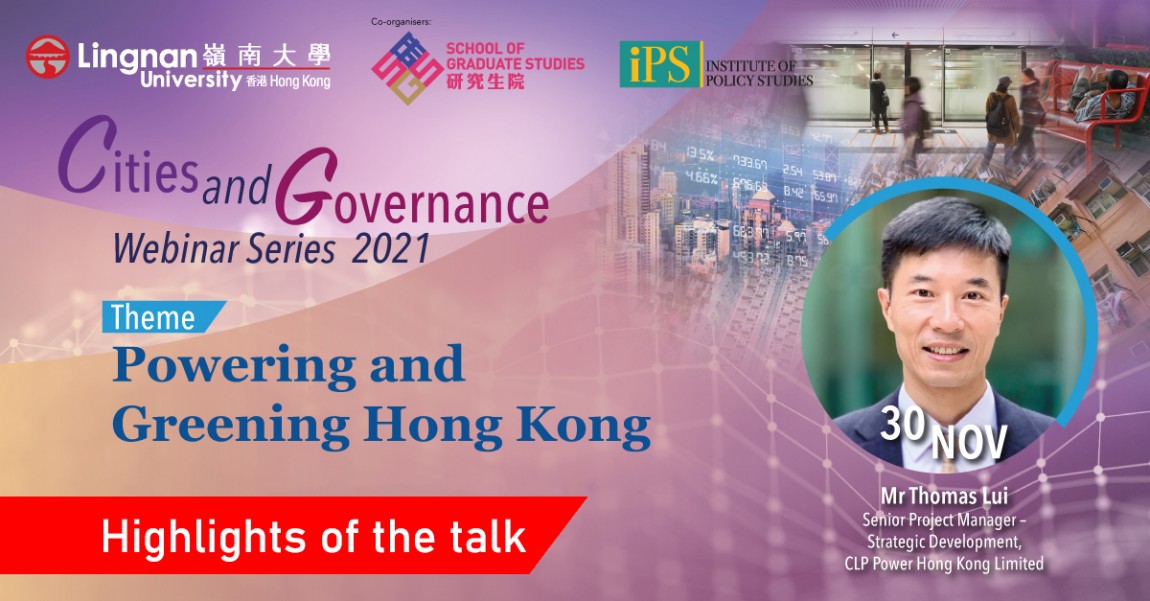Saving the planet will take more than a flick of a switch

For decades scientists have been warning us that the Earth’s climate has been changing due, primarily, to mankind’s reliance on fossil fuels. Today, the evidence of this disruption can be seen all over the planet, in the form of devastating heatwaves, droughts, wildfires, flooding, record-breaking cold snaps, and the like. Many lives, and countless livelihoods, have already been lost, and without concerted global action this trend is only forecast to accelerate.
As part of the world-wide strategy to help mitigate this catastrophe, the final speaker in Lingnan University’s Cities and Governance Webinar Series, Mr Thomas Lui, Senior Project Manager, Strategic Development, CLP Power Hong Kong, set out ways in which Hong Kong can achieve carbon neutrality while maintaining a reliable energy supply to the SAR’s users.
To highlight the urgent need for action, Mr Lui began by citing events from either end of the climate spectrum that have occurred in a single country, the United States, in the past 18 months. In February 2021, Texas was hit by a winter storm during which temperatures dropped to -19°C, 25 degrees below normal. While in the summer of 2020, a Californian heatwave broke records from the past 70 years, with temperatures in Death Valley reaching 54°C. Both events caused major power outages at times when continuity of supply was essential for human well-being.
Targets and challenges
China has committed to ensuring the nation’s CO2 emissions peak before 2030 and that carbon neutrality will be achieved by 2060. While Hong Kong aims to achieve carbon neutrality before 2050. “Most of our energy is currently produced from fossil fuels,” Mr Lui noted.
Electricity currently provides around 55 percent of the energy used in Hong Kong, a much higher percentage than in many of the most developed Western countries, where the proportion is around 20 percent. This disparity is due to factors such as differences in the make up of the local economy, and the transport needs in such a compact and densely popular city. The reliability of the electricity supply is particularly important because of the number of extremely tall buildings serviced by lifts, and because of a public transport system that depends to a significant degree on electrical power, most notably in the form of the MTR.
Mr Lui went on to explain the trade-offs between different sources of energy for electricity generation. While coal is relatively cheap and reliable, its negative impact on our climate and air quality is at the heart of the current crisis. Natural gas is also reliable, and its use results in lower carbon emissions, but it still won’t take us to zero emissions. Even though nuclear power production emits no carbon into the atmosphere, and is relatively cheap, the public has fears around the safety of this technology. Renewal energy (RE) is clean but comes with land and reliability constraints, especially in Hong Kong, and, though its price is falling quickly, it is still relatively expensively. Because solar and wind RE sources are weather-driven and highly intermittent, their wide-spread adoption is also dependent on further enhancements to storage systems, such as batteries.
Recently, Mr Lui added, there is a global push to develop the technologies needed for clean power generation using hydrogen. Currently, however, this is still an expensive option.
Getting to net-zero
Mr Lui then laid out a road map for Hong Kong’s journey to net-zero energy production and use. First, steps should be taken to reduce the overall demand for energy. Second, wherever possible, the end use of energy should be electrified, and power generation should be de-carbonised. Third, hard-to-electrify energy end uses – such as heavy duty and long haul transport, and industrial heating – should de-carbonise by switching to energy sources such as hydrogen, once the relevant technology has been refined. Finally, residual carbon emissions should be offset by processes such as afforestation and workable carbon capture.
This journey has already started, he explained. “Hong Kong had a carbon emission peak in 2014 and in that particular year electricity generation contributed about 70 percent of this.” Transport was the second biggest emitter.
By 2020, both of the SAR’s power companies had increased their use of natural gas, with an estimated reduction in their carbon emissions of over one-third. Over the same period, they maintained a reliable power supply.
“CLP is taking a multi-pronged approach to de-carbonising Hong Kong’s energy supply to the customer,” Mr Lui said. The coal continues to be replaced by natural gas, speeding the de-carbonisation of the local power supply. Feed-in tariffs are payable to customers for any surplus RE they generate. CLP’s power transmission system is being enhanced, and the company plans to develop large-scale offshore wind farms and install advanced battery systems for RE storage. Eventually hydrogen will replace natural gas so the zero emissions target can be reached.
However, Mr Lui said, hitting the 2050 carbon neutrality target requires both supply and demand side action, with consumers also playing their part by choosing more energy efficient cars, water-heating systems, and the like.

